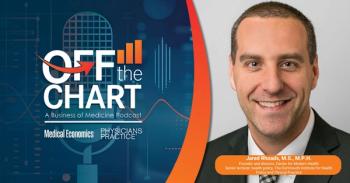
What primary care physicians should know about self-stigma in serious mental illness
Language and treatment approaches carry tremendous weight. Here’s how physicians can make mental health treatment part of whole-person care.
When I sit down with clients living with serious mental illness (SMI), many already minimize what they think about themselves before I even ask a question. They’ve absorbed the negative sentiments the world tells them about mental illness and started to see themselves through that lens.
As primary care physicians (PCPs), you may see that same pattern: people who hold back in conversation, seem unsure about their goals or appear to have accepted that things can’t change. What we’re seeing in these moments — in the hesitation and self-doubt — is self-stigma, or the internalization of society’s negative messages about mental illness. I see it often with my clients: this idea that someone living with schizophrenia is “broken,” “dangerous” or “less than.”
Where does self-stigma come from?
External stigma, or the prejudice, discrimination and exclusion people face from others, doesn’t just harm from the outside. Over time, those messages sink in and people begin to see themselves through that same distorted lens. When society repeatedly tells someone they don’t belong or can’t get better, they start to believe it.
What does self-stigma look like in the exam room?
In the exam room, self-stigma often looks like minimization, withdrawal or self-limitation. I’ve seen people living with schizophrenia stop pursuing education or employment because they’ve been told, explicitly or implicitly, that they won’t succeed.
One client I worked with had been told by his case manager that living on his own wouldn’t be safe. He stopped talking about his goals entirely. When I asked, “Why do you think she said that?” he told me it was because she worried he might stop taking his medicine. So we talked about what safety could look like for him, specifically what he could do to stay consistent with his treatment and feel supported. Over time, he regained confidence. He’s now engaged, working part-time and planning for his own place. When we take the time to ask and listen, we shift the conversation from what someone can’t do to what’s actually possible for them. We must remain curious. Remaining curious increases empathy.
Why does self-stigma matter in primary care?
For people living with SMI, self-stigma can show up at every stage of care. It can keep someone from scheduling appointments or lead them to downplay symptoms they’re experiencing. Feelings of shame or unworthiness may cause them to skip medications or stop following up altogether. Even in conversation, self-stigma can make it harder for them to open up about their goals or share what’s really going on. PCPs are often the most consistent providers in their lives, which creates a powerful opportunity to build trust and help normalize mental health treatment as part of whole-person care.
What treatment approaches help reduce self-stigma?
There are a few key approaches that help reduce self-stigma. First, all health care professionals should be mindful of the way care is delivered. If treatment decisions aren’t built on open communication, empathy and shared decision-making — when we take a paternalistic approach, telling them what to do without asking for their input — they often pull back and self-stigma can begin to take root. On the other hand, when people are included in the plan and feel like their voice matters, they tend to do better and are invested in the treatment plan.
Medication can also play a role. I’m a big fan of long-acting injectables like aripiprazole lauroxil, which is used to treat adults with schizophrenia, because they remove that daily reminder of illness that comes with pills. However, the way we present a different option matters. It’s not, “You didn’t take your medication, so now you need to get a shot.” Instead, it’s, “You’ve told me you’ve missed some doses,” or “You’re worried your lifestyle isn’t conducive to taking daily pills; let’s look at an option that could make things easier.” Framing treatment as an opportunity rather than a punishment changes how people view both the medication and themselves.
What role do families and care partners play in self-stigma?
As both a clinician and a care partner to my daughter, who lives with schizophrenia, I’ve seen the manifestation of self-stigma from both sides. Families truly mean well, but sometimes the things we say or do, such as being overly protective or saying, “You’ll never be able to do that,” can unintentionally reinforce self-doubt. I understand where it comes from. We’ve had some difficult moments, and those memories don’t just disappear. But I remind myself and the families I work with that helping keep our loved ones safe and believing in their abilities are two things that can exist together.
When families take the time to celebrate milestones, encourage independence and talk about schizophrenia as just one part of a person’s life rather than their identity, it helps strengthen confidence and reduce stigma.
What can PCPs do to reduce self-stigma?
Even with the time and system constraints that come with primary care, there are meaningful ways to address self-stigma in everyday practice. One of the most important steps is to normalize the experience. I remind my clients that the shame they feel often comes from messages society has sent, but those messages are wrong. Talking about stigma as something that is external, and not an internal or personal flaw, can help remove the negative feelings that can come with it.
Motivational interviewing and open-ended questions are great tools to guide conversations. Simple questions like, “What are your goals?” or “What matters most to you right now?” give people space to express their values, take ownership of their care and create dialogue with someone who believes in them. In these moments, listening to them is powerful. Time may be limited, but I’ve learned that five minutes of true, uninterrupted listening is incredibly substantial and helpful.
It’s equally important to focus on strengths. I make it a point to reflect on what’s going well, as these small acknowledgments help rebuild confidence over time.
Our language also carries weight. You may have noticed that throughout this piece, I’ve referred to the people I work with as “clients” rather than “patients.” When you call someone a patient, it can automatically place them in the role of “I’m sick and you’re taking care of me.” So, I make a mindful effort to use the word “client” instead, because they’re coming to me for a service I provide, not to be defined by an illness. I also avoid words like “noncompliant,” which place blame, and instead ask, “What barriers are getting in the way?” I say “living with schizophrenia” to emphasize that a diagnosis is just one part of someone’s story, not their whole identity. And I describe “challenges,” which can be worked through, rather than “problems,” which feel discouraging. The words we choose shape how people see themselves and how much hope they hold for what’s possible.
Lastly, psychoeducation is a powerful approach for helping families understand that schizophrenia is a brain-based illness caused by dopamine dysregulation, not a character flaw. I’ve found that when we can help families understand this, they often shift from shame to advocacy. That change ripples outward, reducing self-stigma for their loved one.
Even within the constraints of fragmented care and limited time with each client, language and treatment approaches carry tremendous weight. The way we speak to people, the choices we offer and the hope we communicate can change how they see themselves.
Avoiding stigmatizing language, sharing decisions and focusing on what’s possible helps clients feel valued and capable. And in turn, they can begin to see themselves as whole people living with a condition that can be managed and treated.
Tracy Hicks, DNP, MBA, APRN, FNP-BC, PMHNP-BC, CARN-AP, FIAAN, FIAAP, has a dual certification in psychiatric mental health and family practice. Her focus area is psychiatry and substance use disorders. She has held faculty positions at Texas Christian University, University of Texas at Tyler and Frontier Nursing University. She also holds a certification in addiction through the International Nursing Society on Addictions.
Newsletter
Stay informed and empowered with Medical Economics enewsletter, delivering expert insights, financial strategies, practice management tips and technology trends — tailored for today’s physicians.















